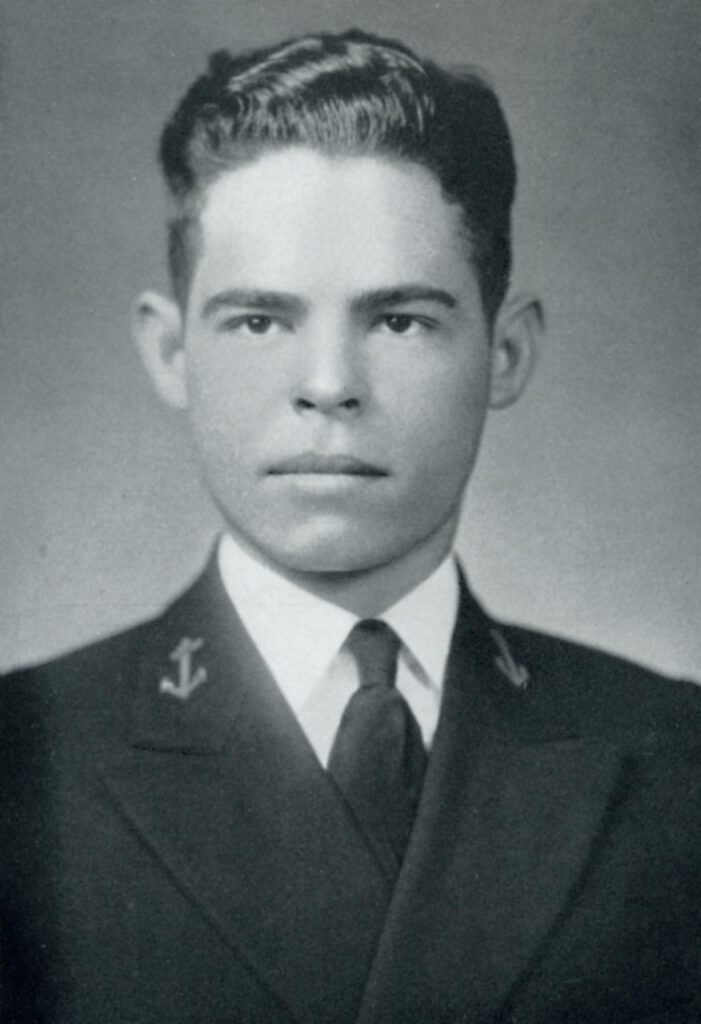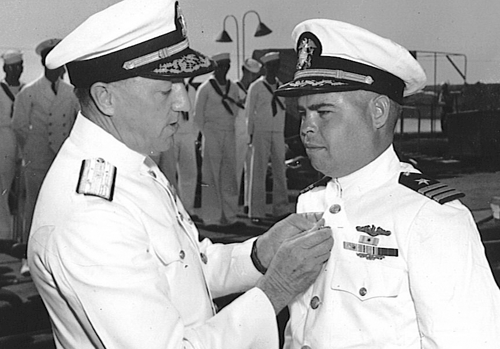
Marion Frederic Ramirez de Arellano was born in San Juan, Puerto Rico, on 5 August 1913, son of Professor Rafael W. de Arellano and Professor Lucille Kemmerer Ramirez de Arellano of the University of Puerto Rico at Río Piedras. He attended that university for two years prior to his entrance to the US Naval Academy, Annapolis, Maryland, as a Midshipman from Puerto Rico, on 21 July 1931. At the Academy he participated in athletics, winning his letter in soccer, tennis and gym (varsity) and was a member of Reef Points (pistol club) and the Electrical Gang. At graduation with the Class of 1935, he won the Society of the Cincinnati prize for standing highest for the course in the Department of Languages. Commissioned Ensign in the US Navy on 6 June 1935, he subsequently attained the rank of Commander, his date of rank 1 March 1944.
When detached from the Naval Academy, he was assigned to the USS Ranger, a unit of Carrier Division ONE, Battle Force, for two years. He had submarine instruction at the Submarine School, New London, Connecticut, and after graduation in January 1938, reported for duty aboard the USS Pickerel, operating with Submarine Division FOURTEEN, Submarine Force. The Pickerel was assigned to the Asiatic Fleet in 1939, and participated in submarine operations in the Pacific early in World War II.
He was awarded a Gold Star in lieu of the second Silver Star Medal “for conspicuous gallantry and intrepidity as Diving Officer of the USS Pickerel during the first five war patrols of that vessel in action against enemy Japanese forces in the Pacific War Area from 8 December 1941 to 26 August 1942…” The citation continues: “Skilled and efficient in his control of depth, (he) was of invaluable assistance to his commanding officer in conducting successful attacks which resulted in the sinking of two hostile freighters and the damaging of another, totaling approximately 15,000 tons…”
Detached from the Pickerel in December 1942, he had brief duty at the Navy Yard, Mare Island, California, and returned to the South Pacific, where from April 1943 to March 1944 he served as Executive Officer and Navigator of the USS Skate. “For exceptionally meritorious conduct… (in that capacity) on board the USS Skate during the First War Patrol of that vessel during operations in enemy Japanese waters in the Wake Island area from 25 September to 29 October 1943…” he was awarded the Legion of Merit. The citation states that he “contributed materially to the success of his vessel in the rescue of five Allied Naval pilots and one enlisted gunner under extremely hazardous conditions, during which his submarine was strafed twice, bombed three times and fired on by shore batteries three times…”
He was also awarded the Silver Star Medal “For conspicuous gallantry and intrepidity in action…as Assistant Approach Officer in the USS Skate during the Third War patrol of that vessel in enemy Japanese controlled waters from 5 February 1944 to 17 March 1944…(he) contributed directly to his vessel’s success in sinking an enemy 7,000 ton light cruiser and in evading severe counter measures…”
He is also entitled to the Ribbon for, and a facsimile of the Navy Unit Commendation awarded the USS Skate for her First, Second, Third and Seventh War Patrols in the Pacific, during the period September 1943 through July 1945.
In April 1944 he assumed command of the USS Balao, and “For distinguishing himself by meritorious services in action in the line of his profession as Commanding Officer of the USS Balao during that vessel’s Sixth War Patrol, from 5 July 1944 to 27 August 1944…” received a Letter of Commendation with ribbon and Combat “V,” from the Commander in Chief, Pacific Fleet. He was also awarded the Bronze Star Medal with Combat “V,” the citation following in part:
Bronze Star Medal: “for heroic service as Commanding Officer of the USS Balao during the Seventh War Patrol of that vessel in enemy Japanese-controlled waters from 4 December 1944 to 10 January 1945. Penetrating shallow and heavily mined waters, Commander Ramirez de Arellano conducted well-planned torpedo attacks to sink a tanker and a schooner totaling over 10,000 tons despite severe enemy countermeasures. His skills, courage and devotion to duty were in keeping with the highest traditions of the United States Naval Service.”
He was detached from command of the Balao in February 1945, and for six months thereafter was assigned to Submarine Division TWO HUNDRED TWO, his duty in connection with relief crews. In August 1945 he became Commander Submarine Division SIXTEEN, with additional duty as a member of the staff of Commander Submarine Squadrons TWENTY-EIGHT and EIGHT. Three months later he was transferred to command the USS Piper, and in April 1946 was detached with orders to duty in command of the Submarine Base at St. Thomas, Virgin Islands.
In November 1947 he reported to Headquarters, Tenth Naval District, where for two years he served as Assistant to the War Plans Officer on the staff of the Commandant and on the staff of Commander Caribbean Sea Frontier. On 10 August 1949 he returned to the Naval Academy, where for the next three years he was assigned to the Department of Language. On 30 September 1952 he assumed command of the USS Lindenwald (LSD-6), a unit of the Atlantic Fleet, and under orders of 17 May 1954 he was detached to Pascagoula, Mississippi as Prospective Commanding Officer of the USS Thomaston. He assumed command at her commissioning on 17 September 1954.
In addition to the Silver Star Medal and Gold Star in lieu of second silver award, the Legion of Merit, the Bronze Star Medal with Combat “V,” the Commendation Ribbon with Combat “V,” and the Ribbon for the Navy Unit Commendation, Commander Ramirez de Arellana had the Army Distinguished Unit Emblem; the American Defense Service Medal with Fleet Clasp; the Asiatic-Pacific Campaign Medal with one silver star and two bronze (seven engagements); the American Campaign Medal; the World War II Victory Medal; the National Defense Medal; and the Philippine Defense Ribbon.
He attained the rank of Captain before retiring in July 1961. Captain Ramierz de Arellano died on 15 May 1980.



Tomas colon